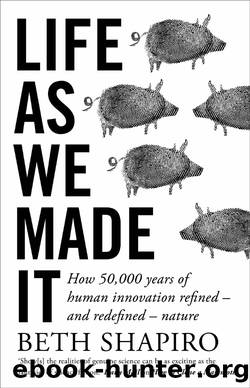Life as We Made It: How 50,000 Years of Human Innovation Refined â and Redefined â Nature by Beth Shapiro

Author:Beth Shapiro [Shapiro, Beth]
Language: eng
Format: epub
Tags: nature, Ecosystems & Habitats, General, science, Life Sciences, biology, Genetics & Genomics, animals, Evolution, Ecology, Earth Sciences
ISBN: 9781786079411
Google: y-AwEAAAQBAJ
Publisher: Oneworld Publications
Published: 2021-10-21T23:28:46.589449+00:00
HORNLESS HOLSTEINS
Buri, Princessâs father, was born in 2015 on a farm in Minnesota. He was one of several bull calves born that spring using a process called somatic cell nuclear transfer or, more commonly, cloning. Cloning involves creating an entire organism starting not from the cell that forms when a sperm fertilizes an egg, but from another cellâa somatic cellâtaken from some other tissue in the body. At a super basic level, cloning happens like this: An unfertilized egg cell is harvested and its nucleusâwhere the DNA isâis removed and replaced with the somatic cellâs nucleus. Then, in a step called reprogramming, proteins in the egg cell trick the somatic cellâs genome into forgetting how to be whatever type of cell it was (a skin cell or mammary cell perhaps) and reverting to the type of cell that forms when a sperm fertilizes the eggâthe type of cell that can divide and differentiate into all the different cell types that make up a whole organism. Cloning has been commonplace in cattle agriculture and, by 2015, the birth of healthy cloned calves was welcome but not particularly earth-shattering news. Buri, however, was not only a clone. He was a gene-edited clone.
Buriâs genome was edited by scientists at a biotech company called Recombinetics. Their goal was to delete, in an early stage embryo, a small string of DNA letters on cattle chromosome 1 and replace it with a different, slightly longer string of DNA letters. Individualsâ genomes often have slightly different versions of the same stretch of DNA, and these versions are called alleles. If Recombinetics was successful in swapping one allele for the other, the resulting animal would not grow horns.
Hornlessness, which is also known as âpolled,â has been observed in domestic cattle for millennia. The oldest evidence of polled cattle is from ancient Egyptian art depicting children milking cows without hornsâa sign that hornlessness might also have been associated with docility. Dozens of European archaeological assemblages dating to within the last 4,000 years include hornless cattle skulls, suggesting that farmers across cultures were choosing hornless cattle over their horned brothers and sisters. The allele that Recombinetics was working with is estimated to have evolved just over 1,000 years ago, and it is one of several polled mutations found in todayâs cattle breeds.
Itâs easy to imagine why herders and farmers throughout history preferred hornless cattle. Hornless animals are easier to herd, move, and milk. Horns are sharp, and being poked with them can hurt both other cattle and any person who happens to get in the way. Hornless cattle can live in higher densities, and a cattle farmer whose net worth is determined by the number of heads of cattle on his land can accommodate more heads when those heads lack horns. Hornless cattle are so highly valued today that farmers often choose (or are compelled by legislation) to remove horns surgically.
In the United States, around 15 million calves are surgically dehorned each year. Dehorning is an unpleasant, expensive, and painful process that, unsurprisingly, raises significant concerns related to farm animal welfare.
Download
This site does not store any files on its server. We only index and link to content provided by other sites. Please contact the content providers to delete copyright contents if any and email us, we'll remove relevant links or contents immediately.
| Automotive | Engineering |
| Transportation |
Machine Learning at Scale with H2O by Gregory Keys | David Whiting(4179)
Never by Ken Follett(3790)
Urban Outlaw by Magnus Walker(3340)
OPNsense Beginner to Professional by Julio Cesar Bueno de Camargo(3251)
Sapiens and Homo Deus by Yuval Noah Harari(2987)
Will by Will Smith(2793)
A Short History of Nearly Everything by Bryson Bill(2629)
Hooked: A Dark, Contemporary Romance (Never After Series) by Emily McIntire(2500)
Rationality by Steven Pinker(2291)
Borders by unknow(2229)
The Becoming by Nora Roberts(2087)
Holy Bible (NIV) by Zondervan(2086)
The One Percenter Encyclopedia by Bill Hayes(1787)
HBR's 10 Must Reads 2022 by Harvard Business Review(1777)
Freedom by Sonny Barger(1771)
A Short History of War by Jeremy Black(1762)
Five Ways to Fall by K.A. Tucker(1700)
Go Tell the Bees That I Am Gone by Diana Gabaldon(1687)
Girls Auto Clinic Glove Box Guide by Patrice Banks(1685)
